| The science of ballistics is not as simple as many would make it seem. What a bullet does in flight can vary due to factors you would never think possible. Modern ballistics calculators, available as hand held units in the several hundreds of dollars, have been around for some time. With the advent of smart phones, you no longer need a separate hand held calculator (unless you’re in a situation where you need the physical toughness of the unit itself). The problem is, all of the name brand phone calculators were developed for the Apple Iphone, which means if you are running the Android operating system from Google, you can’t use them. Run a search in the Android Marketplace for “ballistics calculators” and you’ll find some free apps and some paid apps. I decided to download several of them and see what the differences are, and if they actually work. Please excuse the screen capture pictures for this article. Android has a funny quirk that I hope they cure in future editions: None of the screen capture apps work on a phone that hasn’t been what is called “rooted.” To do this takes yet another app that is high risk. It allows you to take over your phone, or jailbreak it as they say with the Apple phones, but you can seriously mess up your phone. I have chosen to not “root” my phone yet, so the pictures of the screens were taken with a regular camera and it had a hard time dealing with the focus and luminosity issues. The lack of screen capture plays an important role with Android when it comes to programs like these. Only one of the applications exports a range card, so for the rest you will be entirely dependent on using the application in the field or on the range, on the phone itself. They don’t depend on phone lines, but if you kill your battery playing Angry Birds or using your GPS, you’ll be out of luck when you get to the range. | 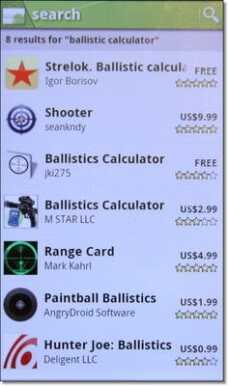 The Android Marketplace offers both free and paid apps for ballistics. Some are great, some not so great. |
Even though it comes up second on the list, we might as well start with the highest priced paid app. It’s a whopping ten bucks. I know, half of what you pay for parking at a baseball game, but it is paid and as with most things in the Android Marketplace, you get what you pay for. I can’t imagine that there would be any variables that you would want to include in your calculations that aren’t in Shooter. Some things I don’t even understand and I hope to do some research and experimentation to see how much of an effect they have in long range shooting. Can you dial in all of your parameters on Shooter and take an 856 yard shot based on the calculations? I don’t know, but I do hope to test it at some point. If you want to nerd out on ballistics in the meantime, this is your app. What makes this app different from all the others is that it not only has advanced features, it can also connect to the internal GPS of the phone to get atmospheric conditions, based on national weather service numbers, as well as being able to connect to a Kestrel weather station to get atmospheric and wind conditions live. You can store as many rifles and bullets as you want. The only caveat, of course, is that the muzzle velocity you enter on the ammo is for a specific measured rifle, or at least barrel length, but due to variances in width, you really can’t count on a standard barrel length to shoot the same velocity in every rifle. Please note that many of these features can be disabled by putting the app in Simple Mode. This is done from the start screen by pushing your settings button. You can also control distance units and whether your GPS inputs values by default.
| |||||
This is an actual GPL (general public license) piece of software that is available for Android. It’s a little clunky and you can’t save any profiles, but it does what you want it to do for the most part. By now I expect you are spoiled with features. This really one has none, but it works.
| |||||
| |||||
 Hunter Joe Ballistics – $0.99 Hunter Joe Ballistics – $0.99 At the price of a dollar, I’m not sure it is a huge jump to try this interesting but mostly useless app for Android. I don’t know why they would go to the lengths to make something so good looking with such little practical function. From what I can tell, it’s geared for hunters with very little ballistic knowledge.
| |||||
| ||||

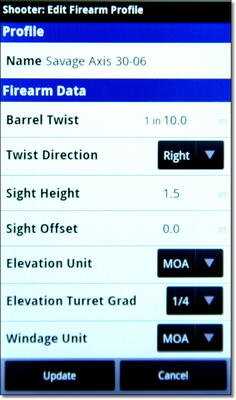
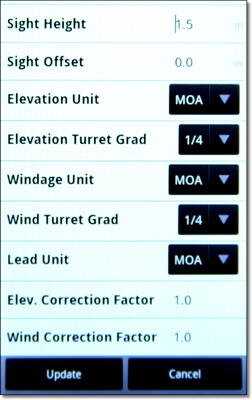
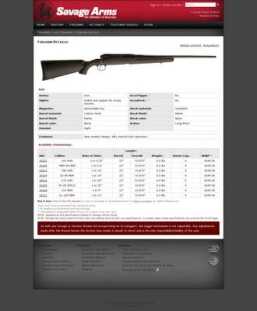

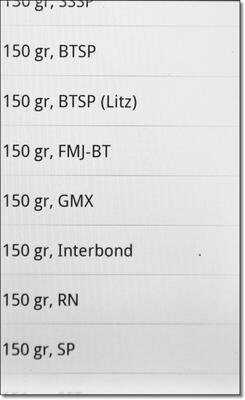
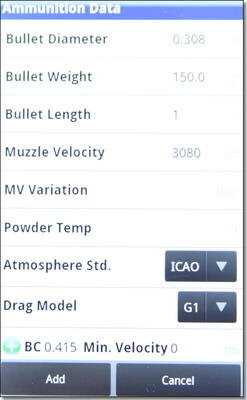

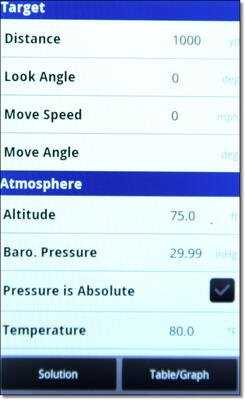
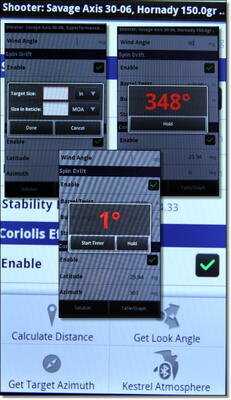
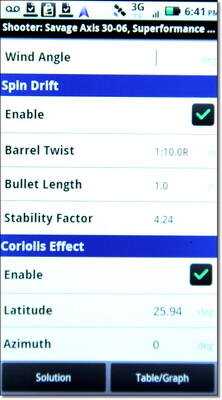
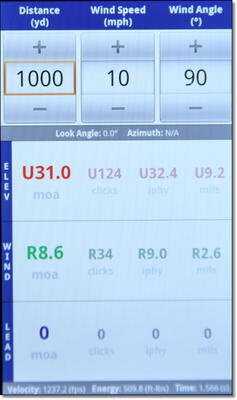

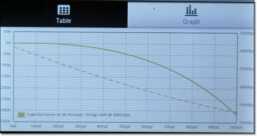
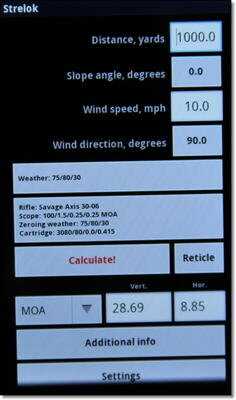
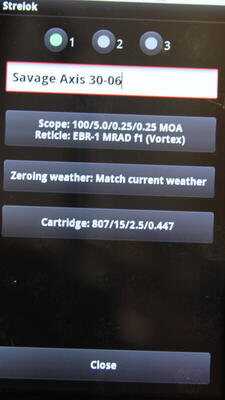
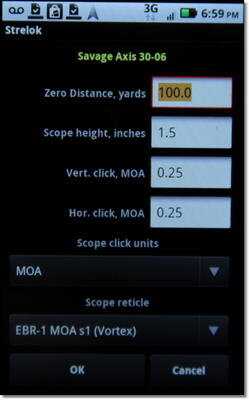
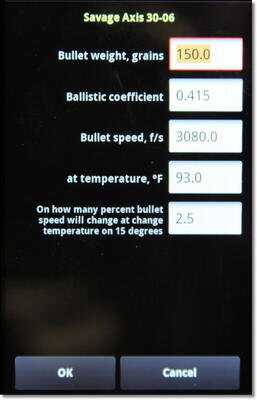
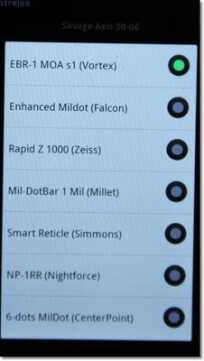
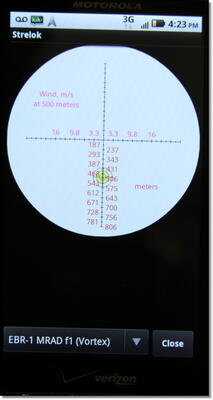
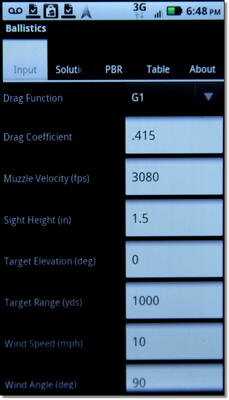
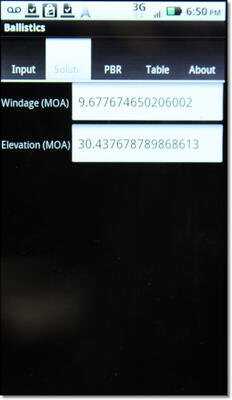
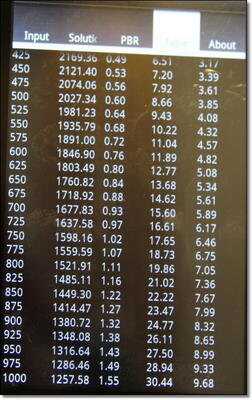
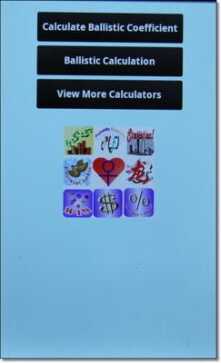
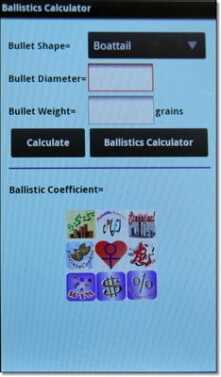
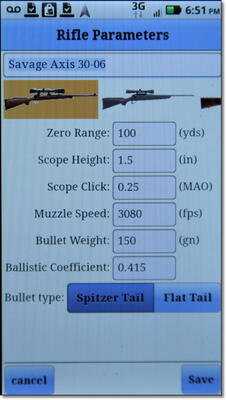
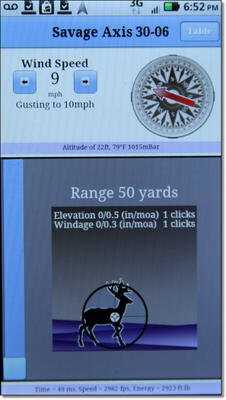
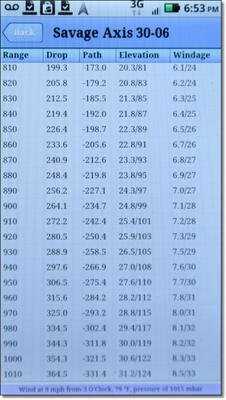
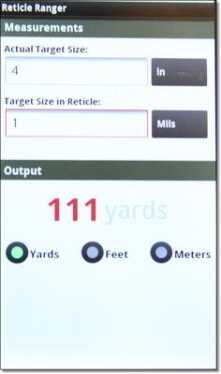
how do I get this for my phone, and also can I get this on my home computer?
Now we’re cooking… problem solved. Due to my ignorance about such matters and a somewhat vague owners manual for my scope regarding what’s what… I was set up wrong. You were correct… my scope turrets are set up in MOA increments. Thank you for staying with me on this one. I now have a much better understanding of MILS and MOA. Be well and stay safe.
Bought “shooter” and set it up just as describ4ed in this post. Zeroed at 100 yards, 1/4 turret grad clicks. Ballistic chart shows a 4″ drop at 200 yards but program says “U2”. That would only be a 1 inch rise in POI. soooo tried to get a answer from the Shooter Net but no answer. Whats wrong with program?
Did you set the zero distance correctly? I would check it against internet and strelok.
Yup.. just rechecked it. ,308 cal .. Barrel twist 1 in 10 Right. Elevation and Wind Units set at Mils and Elevation and Wind Turrets set at 1/4. Used programs bullet data for 175 gr Sierra BTHP. Zero set at 100 yards. Programs chart shows a drop just a smidge over 4″ at 200 but solution for 200 yards shows “U2” I know I’m a novice at all this but me thinks it should show “U8”. Right???
The velocity is more important than anything.
Understood. Velocity is set at 2600. At 200 yard shooting solution with 100 yard zero app says U0.6 mils.. U2 clicks… U2.1 moa…U2.2 iphy. Shooting solution for 400 yards says:: U2.4 mils… U10 clicks… U8.4 mils… U8.8 iphy. Seems clear that App is not correct re “1/4 clicks” Can’t figure out how to correct the error and “Shooter.net” hasn’t responded to my inquires.
I don’t know it sounds like your scope is in MOA and you are getting data in mils. Switch the data to MOA. Mil scopes click in 1/10 mil increments. One mil is larger than one MOA and you can’t swap them. Read the article recently here on first focal plane scopes it explains it.
Late comment but for someone down the road U2 may mean up 2 MOA which is 4 inches at 200 yards.
Would be a useful review if we could actually read it. Seems your adverts cover 1/4 of the right side of your review.
When you get that fixed i will com back and read what you think about these apps.
Yes, that was annoying
Not listed as a separate part is a gasket in the bottom of each blade.
Grill a few minutes on each side, until very golden.
Beverages, breads, desserts, main courses, salads, and dressings – there was a Tupperware recipe for every part of a meal.
It also incorporates some other technologies including a triple
action cutting system and Active – Lift technology which work along
with Braun’s Pulsonic technology to give a very close and comfortable shave.
This is the main reason why it is very important that you know
how to shave properly. A well-known such as going to be the Philips NIVEA FOR MEN 8060X
allows you for more information about have a from coast to coast
moist shave in the shower and comes allowing you to have its personal
moisturizing shaving conditioner.
Look hard at the $30 Applied Ballistics. Yes, it costs money. Yes, it is hands down the best shooting applied ballistics calculator available for Droid at this time. If you are serious, you have to pay fo rit. If you are serious, you probably aren’t looking for ‘free’ either
SoCal heard good reviews about it but for 29.00 will just use my brain.
There is another one cannot remember the name but the cost is $29.00.
Hello, I enjoyed reading this very informant article, thank you for the reviews. I immediately searched for some apps on android market, I came across an app called Applied Ballistics for $29.99 I read into and it seems to have all the bells and whistles and very accurate as well. Has anyone used this app?
Thanks
This is also Bryan Litz and it looks a lot like Shooter. I just downloaded it and will try to put together a review at some point soon.
you can take screenshots on android without rooting by pushing the home & power button at the same time. at least with galaxy s2
Just an Android note on the screen capture…I have a Galaxy Nexus (Verizon CDMA) that runs the latest version of Android OS (ICS) and it does the screen capture and save them as pictures.
I’ll second the request for shot timer appps for Android.
they are already on my phone and working on it.
I use Ballistics from MES Enterprises on my blackberry.
In defence of Hunter Joe: Ballistics, Reviewer didn’t realize that a lost of parameters can be set through the Android menu key.
All you can do is edit the weather and go to the weather channel website, which I’m pretty good at doing without Hunter Joe. It is a dreadful paid application and should be removed from the marketplace and redesigned. I see where you were going with it, but you never got there.
I have and use Shooter. The first time I used it was for my first F-TR match which was the first time I had shot any real distance with a scoped rifle. I was using a new Remington 700 I had zeroed at 100 yards. I had already loaded the rifle and bullet info into the program days before and when I told the program I was going to be shooting at 600 yards it gave me a +16 MOA adjustment.
The day of the match I turned on the program. It pulled in the local atmospheric and weather conditions and confirmed I still needed +16 MOA but now with the wind it gave me an adjustment of 10 clicks left. I dialed the scope in, took my first shot and was in the 9 ring just left of the X.
Needless to say I was much impressed.
I also have Strelock. Like the story says it’s not as robust as Shooter. But what is is great for is to give you the sight picture and hold overs with your reticle.
Get both programs and they’ll do you right.
I’ve used shooter for over a year now, and it’s by far the best I’ve found that wasn’t ungodly expensive and proprietary (there are a couple of really nice ones from big names in the ballistics and defense fields).
I used it at boomershoot this year, and it had me on target to within the precision of my rifles (two different rifles, 4 different loads) and my own abilities, every single time.
It’s more than worth the $10.
What magnification does the mildot rangefinder work on?
It depends if the scope is first or second focal plane. On a second focal plane the manufacturer will tell you what magnification. On a first focal plane like our Vortex Razor HD there is no difference and you can use it throughout the whole zoom range and it is the same.
Blackberry??
not that I know of
Screen Shot It is a cheap screen cap program that works on any android 2.2 and above, rooted or not. My phone isn’t rooted and it works fine.
Great reviews on these apps, very useful knowledge!
Great article. How about a follow up on shot timers. Have seen for iphone but not much on android.
Thou shalt not disparage Android to Apple’s favor.
FYI:
The browser for Android called Dolphin or Dolphin HD is my default browser on my un-rooted phone. It has an optional feature, an add-on, that is a great tool got screen captures. You can choose one of 3 options.
1) Whole page
2) Page content (less ads etc.)
3) Select area, using an easy crop tool.
Once you choose you can save or share.
Thank you for posting this review. I’m new to the whole ballistics game, and this will certainly save me plenty of time and aggravation!